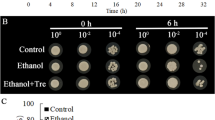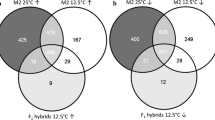Abstract
Induction of the oxidative stress response has been described under many physiological conditions in Saccharomyces cerevisiae, including industrial fermentation for wine yeast biomass production where cells are grown through several batch and fed-batch cultures on molasses. Here, we investigate the influence of aeration on the expression changes of different gene markers for oxidative stress and compare the induction profiles to the accumulation of several intracellular metabolites in order to correlate the molecular response to physiological and metabolic changes. We also demonstrate that this specific oxidative response is relevant for wine yeast performance by construction of a genetically engineered wine yeast strain overexpressing the TRX2 gene that codifies a thioredoxin, one of the most important cellular defenses against oxidative damage. This modified strain displays an improved fermentative capacity and lower levels of oxidative cellular damages than its parental strain after dry biomass production.





Similar content being viewed by others
References
Aranda A, Querol A, del Olmo M (2002) Correlation between acetaldehyde and ethanol resistance and expression of HSP genes in yeast strains isolated during the biological aging of sherry wines. Arch Microbiol 177:304–312
Beudeker RF, van Damm HW, van der Plaat JB, Vellenga K (1990) Developments in baker’s yeast production. In: Verachtert H, deMot R (eds) Yeast: biotechnology and biocatalysis. Marcel Dekker, New York, pp 103–146
Buege JA, Aust SD (1978) Microsomal lipid peroxidation. Methods Enzymol 52:302–310
Costa V, Moradas-Ferreira P (2001) Oxidative stress and signal transduction in Saccharomyces cerevisiae: insights into ageing, apoptosis and diseases. Mol Aspects Med 22:217–246
de Koning W, van Dam K (1992) A method for the determination of changes of glycolytic metabolites in yeast on a subsecond time scale using extraction at neutral pH. Anal Biochem 204:118–123
Dimster-Denk D, Rine J (1996) Transcriptional regulation of a sterol-biosynthetic enzyme by sterol levels in Saccharomyces cerevisiae. Mol Cell Biol 16:3981–3989
Espindola AS, Gomes DS, Panek AD, Eleutherio EC (2003) The role of glutathione in yeast dehydration tolerance. Cryobiology 47:236–241
Garrido EO, Grant CM (2002) Role of thioredoxins in the response of Saccharomyces cerevisiae to oxidative stress induced by hydroperoxides. Mol Microbiol 43:993–1003
Gasch AP, Spellman PT, Kao CM, Carmel-Harel O, Eisen MB, Storz G, Botstein D, Brown PO (2000) Genomic expression programs in the response of yeast cells to environmental changes. Mol Biol Cell 11:4241–4257
Gibson BR, Lawrence SJ, Boulton CA, Box WG, Graham NS, Linforth RST, Smart KA (2008) The oxidative stress response along a lager brewing yeast strain during industrial propagation and fermentation. FEMS Yeast Res 8:574–584
Gietz RD, Schiestl RH, Willems AR, Woods RA (1995) Studies on the transformation of intact yeast cells by the LiAc/SS-DNA/PEG procedure. Yeast 11:355–360
Gimeno-Alcañiz JV, Matallana E (2001) Performance of industrial strains of Saccharomyces cerevisae during wine fermentation is affected by manipulation strategies based on sporulation. Syst Appl Microbiol 24:639–644
Godon C, Lagniel G, Lee J, Buhler JM, Kieffer S, Perrot M, Boucherie H, Toledano MB, Labarre J (1998) The H2O2 stimulon in Saccharomyces cerevisiae. J Biol Chem 273:22480–22489
Grant CM (2001) Role of the glutathione/glutaredoxin and thioredoxin systems in yeast growth and response to stress conditions. Mol Microbiol 39:533–541
Gustafsson L (1979) The ATP pool in relation to the production of glycerol and heat during growth of the halotolerant yeast Debaryomyces hansenii. Arch Microbiol 120:15–23
Haarasilta S, Oura E (1975) On the activity and regulation of anaplerotic and gluconeogenetic enzymes during growth process of baker’s yeast. Eur J Biochem 52:1–7
Hohmann S, Mager WH (2003) Yeast stress responses. Springer, Heidelberg
Holmgren A (1989) Thioredoxin and glutaredoxin systems. J Biol Chem 265:13963–13966
Ivorra C, Pérez-Ortín JE, del Olmo M (1999) An inverse correlation between stress resistance and stuck fermentations in wine yeasts. A molecular study. Biotechnol Bioeng 64:698–708
Jamieson DJ (1998) Oxidative stress responses of the yeast Saccharomyces cerevisiae. Yeast 14:1511–1527
Jorgensen H, Olsson L, Ronnow B, Palmqvist EA (2002) Fed-batch cultivation of baker’s yeast followed by nitrogen or carbon starvation: effects on fermentative capacity and content of trehalose and glycogen. Appl Environ Microbiol 59:310–317
Koerkamp MG, Rep M, Bussemaker HJ, Hardy GPMA, Mul A, Piekarska K, Szigyarto CA, Teixeira de Mattos JM, Tabak HF (2002) Dissection of transient oxidative stress response in Saccharomyces cerevisiae by using DNA microarrays. Mol Biol Cell 13:2783–2794
Larsson C, Påhlman IL, Ansell R, Rigoulet M, Adler L, Gustafsson L (1998) The importance of the glycerol 3-phosphate shuttle during aerobic growth of Saccharomyces cerevisiae. Yeast 14:347–357
Monje-Casas F, Michán C, Pueyo C (2004) Absolute transcript levels of thioredoxin- and glutathione-dependent redox systems in Saccharomyces cerevisiae: response to stress and modulation of growth. Biochem J 383:139–147
Moye-Rowley WS (2003) Regulation of the transcriptional response to oxidative stress in fungi: similarities and differences. Eukaryot Cell 2:381–389
Muller EGD (1996) A glutathione reductase mutants of yeast accumulates high levels of oxidized glutathione and requires thioredoxin for growth. Mol Biol Cell 7:1805–1813
Nagodawithana TW, Trivedi NB (1990) Yeast selection for baking. In: Panchal CJ (ed) Yeast strain selection. Marcel Dekker, New York, pp 139–184
Parks LW, Casey WM (1995) Physiological implications of sterol biosynthesis in yeast. Annu Rev Microbiol 49:95–116
Panadero J, Hernández-López MJ, Prieto JA, Randez-Gil F (2007) Overexpression of the calcineurin target CRZ1 provides freeze tolerance and enhances the fermentative capacity of baker’s yeast. Appl Environ Microbiol 73:4824–4831
Pereira MD, Eleutherio ECA, Panek AD (2001) Acquisition of tolerance against oxidative damage in Saccharomyces cerevisiae. BMC Microbiol 1:11
Pérez-Torrado R, Gimeno-Alcañiz JV, Matallana E (2002a) Wine yeast strains engineered for glycogen overproduction display enhanced viability under glucose deprivation conditions. Appl EnvironMicrobiol 68:3339–3344
Pérez-Torrado R, Carrasco P, Aranda A, Gimeno-Alcañiz JV, Pérez-Ortín JE, Matallana E, del Olmo M (2002b) Study of the first hours of microvinification by the use of osmotic stress-response genes as probes. Syst Appl Microbiol 25:153–161
Pérez-Torrado R, Bruno-Barcena JM, Matallana E (2005) Monitoring stress-related genes during the process of biomass propagation of Saccharomyces cerevisiae strains used for wine making. Appl Environ Microbiol 71:6831–6837
Puig S, Perez-Ortín JE (2000) Expression levels and patterns of glycolytic yeast genes during wine fermentation. Syst Appl Microbiol 23:300–303
Querol A, Barrio E, Ramón D (1992) A comparative-study of different methods of yeast-strain characterization. Syst Appl Microbiol 15:439–446
Rizzi M, Baltes M, Theobald U, Reuss M (1997) In vivo analysis of metabolic dynamics in Saccharomyces cerevisiae: II. Mathematical model. Biotechnol Bioeng 55:592–608
Rodrigues-Pousada CA, Nevitt T, Menezes R, Azevedo D, Pereira J, Amaral C (2004) Yeast activator proteins and stress response: an overview. FEBS Lett 567:80–85
Rose AH, Vijaylakshimi G (1993) Baker’s yeasts. In: Rose AH, Harrison JS (eds) The yeasts, vol 5. 2nd edn. Academic Press, London, pp 357–397
Rosen K (1989) Preparation of yeast for industrial use in the production of beverages. In: Cantarelli C, Lanzarini G (eds) Biotechnology applications in beverage production. Elsevier Applied Science, London, pp 169–187
Servouse M, Karst F (1986) Regulation of early enzymes of ergosterol biosynthesis in Saccharomyces cerevisiae. Biochem J 240:541–547
Theobald U, Mailinger W, Baltes M, Rizzi M, Reuss M (1997) In vivo analysis of metabolic dynamics in Saccharomyces cerevisiae: I. Experimental observation. Biotechnol Bioeng 55:305–316
Toledano MB, Delaunay A, Biteau B, Spector D, Azevedo D (2003) Oxidative stress responses in yeasts. In: Hohmann S, Mager WH (eds) Yeast stress responses. Springer, Berlin, pp 241–287
Toledano MB, Kumar C, Le MN, Spector D, Tacnet F (2007) The systems biology of thiol redox system in Escherichia coli and yeast: differential functions in oxidative stress, iron metabolism and DNA synthesis. FEBS Lett 581:3598–3607
Walker GM (1998) Yeast physiology and biotechnology. Wiley, Chichester
Wu AL, Moye-Rowley WS (1994) GSH1, which encodes γ-glutamylcysteine synthetase, is a target gene for yAP-1 transcriptional regulation. Mol Cell Biol 14:5832–5839
Zuzuarregui A, del Olmo M (2004a) Expression of stress response genes in wine strains with different fermentative behaviour. FEMS Yeast Res 4:699–710
Zuzuarregui A, del Olmo M (2004b) Analyses of stress resistance under laboratory conditions constitute a suitable criterion for wine yeast selection. Antonie Van Leeuwenhoek 85:271–280
Zuzuarregui A, Carrasco P, Palacios A, Julien A, del Olmo M (2005) Analysis of the expression of some stress induced genes in several commercial wine yeast strains at the beginning of vinification. J Appl Microbiol 98:299–307
Acknowledgments
This work was supported by grants AGL2002-01109, AGL 2005-00508 from the “Ministerio de Educación y Ciencia” (MEC), and GRUPOS03/012 and GVACOMP2007-157 from the “Generalitat Valenciana”. R.P.-T. was supported by a predoctoral fellowship from “Generalitat Valenciana” and R.G.-P. is a predoctoral fellow of the I3P program of “Consejo Superior de Investigaciones Científicas” (Spain). We thank Dr. E. Garre for critical reading of the manuscript.
Author information
Authors and Affiliations
Corresponding author
Rights and permissions
About this article
Cite this article
Pérez-Torrado, R., Gómez-Pastor, R., Larsson, C. et al. Fermentative capacity of dry active wine yeast requires a specific oxidative stress response during industrial biomass growth. Appl Microbiol Biotechnol 81, 951–960 (2009). https://doi.org/10.1007/s00253-008-1722-9
Received:
Revised:
Accepted:
Published:
Issue Date:
DOI: https://doi.org/10.1007/s00253-008-1722-9




